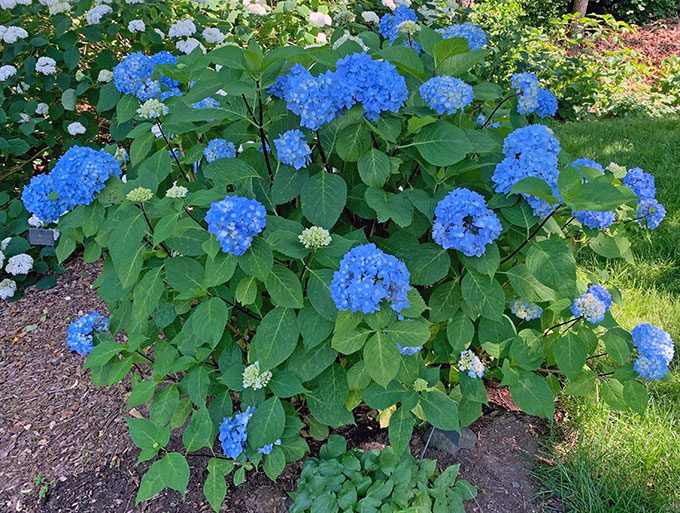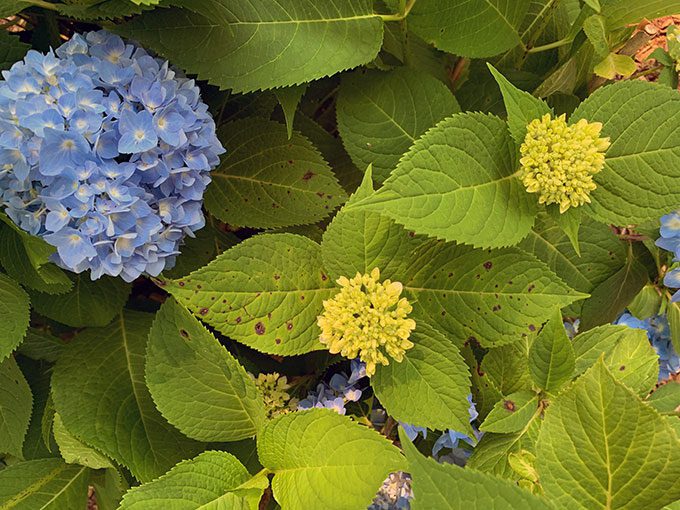Tips For Hydrangea Success
Tips For Hydrangea Success
In this week’s post we celebrate the Hydrangea with tips for solving problems and having success with blue and pink-flowering plants; learn about changing color, dealing with browned flowers, spots on the leaves and drying the blossoms.
The Cape Cod Hydrangea Festival starts this week, and Country Garden is so pleased to be a part of this annual event. If you live on the Cape or nearby, be sure to print out this schedule of events and addresses of open gardens from the Cape Cod Chamber website, and Country Garden’s Hydrangea Festival Flyer from our events page.
In the meantime, here are 5 tips for successful Hydrangea growing and flowering.
1. If you are using aluminum sulfate to make soil more acidic (and change the flowers from pink to blue) be sure to mix it in water and only apply it to well-hydrated plants. Using too much can cause flowers and foliage to brown. Note too that some hydrangeas don’t change color in response to soil pH…find out what variety of hydrangea you have and check to see if it is responsive to alkalinity or acidity.
2. Even in moist soils most hydrangeas will droop when the hot sun hits them. This is because the plant can’t take moisture up from the ground fast enough to replace the water that’s been respired through the pores of the leaves. Don’t be tempted to squirt the plant’s foliage with water when the plant has wilted like this…it doesn’t help but could contribute to leaf-spot fungus.
3. Hydrangeas are prone to leaf-spot fungal infections that cause brown dots on the leaves and sometimes even browning of entire leaf edges. Although the frequent rain this spring caused most leaf spots we see in the summer, frequent irrigation or splashing from hand watering can contribute to this problem. Water deeply less often, and avoid watering in the evening or at night. Note that research shows that some varieties are more prone to leaf spot than others, which can explain why some of your plants might look worse than others.
4. Once flowers have turned brown you can improve the look of the plant by clipping them off just below the dried bloom. This won’t affect flowering for next season, and on varieties that re-bloom such as Endless Summer, it might hasten the second flowering in the fall.
5. Blue hydrangeas won’t dry well when the flowers are fresh, sky blue. Wait until fall when they turn from true blue to a lavender color, and look a bit papery. That’s when you can pick them and dry the flowers. You don’t have to hang the flowers upside down…just put them in a vase with only a little water and they will dry naturally as the water is used up.
6. If your mopheads or lacecaps didn’t flower well this year, remember to not cut them down this fall or next spring. Do not attempt to “neaten them up” or “renew their growth.” Prune off only dead, bare canes in late May of next year, but always leave any cane with green growth on it.

The depth of flower color has more to do with genetics than what you do with the soil. A light blue variety won’t turn this deeper blue. This plant is Enchantress.

Leaf spot on hydrangeas is made worse by frequently splashing the foliage with water. Avoid irrigation or hand-watering that hits the leaves too often.

Hydrangea flowers that are in full sun will brown faster than those that are shaded from 11 AM on. If your blue hydrangeas are in the full sun they will probably wilt every day it’s hot, even if the soil is wet. This constant wilting causes the flowers to go by faster. Enjoy the flowers in July but know that you’ll most likely be clipping off brown blossoms in August.
Subscribe To Our Newsletter
Sign up for our weekly email about sales and events.
